Sevilla
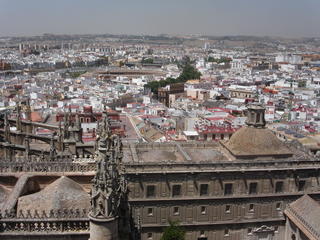 According to legend, Sevilla was founded by Hercules and its origins are linked with the Tartessian civilisation. When you visit this city, you are in the very heart of Andalusian culture, the center of bullfighting and Flamenco music.
According to legend, Sevilla was founded by Hercules and its origins are linked with the Tartessian civilisation. When you visit this city, you are in the very heart of Andalusian culture, the center of bullfighting and Flamenco music.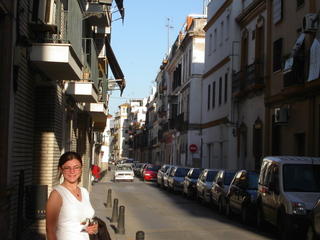 The legendary "Don Juan" started from here to conquer the hearts of women across all Europe, while Columbus started from a port close to Seville to discover a new world.
The legendary "Don Juan" started from here to conquer the hearts of women across all Europe, while Columbus started from a port close to Seville to discover a new world.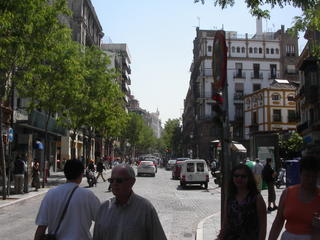 Centro Historico-- This is the heart of historic Seville, and contains its most imposing sights. Barrio Santa Cruz, the former ghetto of Seville's Jews, it's today named after a Christian saint, and is the single most colorful part of the city.
Centro Historico-- This is the heart of historic Seville, and contains its most imposing sights. Barrio Santa Cruz, the former ghetto of Seville's Jews, it's today named after a Christian saint, and is the single most colorful part of the city. Sevilla is credited with the invention of "tapas" and has more than a thousand bars where the choice of food, is virtually unlimited, from seafood to ham and sausage and from vegetable to cheese. This bar was almost empty when I went to the bar to order a couple beers when suddenly tons of people showed up and started to order "chipis," so we felt that we should find out what was the craze all about. Well, "chipis" were octopi boiled with some spices; the "chipis" were great.
Sevilla is credited with the invention of "tapas" and has more than a thousand bars where the choice of food, is virtually unlimited, from seafood to ham and sausage and from vegetable to cheese. This bar was almost empty when I went to the bar to order a couple beers when suddenly tons of people showed up and started to order "chipis," so we felt that we should find out what was the craze all about. Well, "chipis" were octopi boiled with some spices; the "chipis" were great.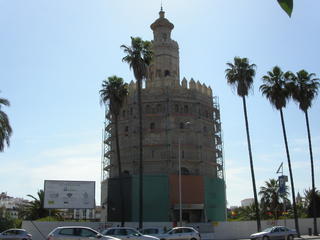 La Torre del Oro (The Tower of Gold) exactly how the tower received its name is a little unclear. Some reports indicate, in Moorish times the tower was gilded in gold. Others believe the tower's name was derived from its use during the time of Christian Monarchs, when gold from the Americas was transported off the ships and stored in the Tower
La Torre del Oro (The Tower of Gold) exactly how the tower received its name is a little unclear. Some reports indicate, in Moorish times the tower was gilded in gold. Others believe the tower's name was derived from its use during the time of Christian Monarchs, when gold from the Americas was transported off the ships and stored in the Tower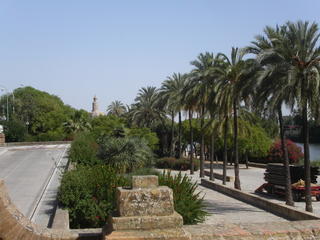 Jardines Rafael Montesinos are situated along the banks of the Darsena del Rio Guadalquivir. At one end of the gardens you can see La Torre del Oro
Jardines Rafael Montesinos are situated along the banks of the Darsena del Rio Guadalquivir. At one end of the gardens you can see La Torre del Oro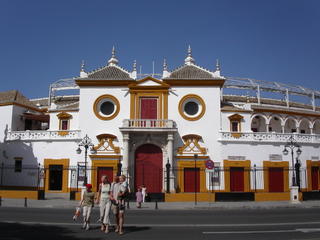 Plaza de Toros la Maestranza: This magnificent bullring is considered to be one of the finest in Spain and is one of the oldest and most important in the world. The 'Catedral del Toreo' is the perfect place to experience the electric atmosphere of a corrida (bullfight).
Plaza de Toros la Maestranza: This magnificent bullring is considered to be one of the finest in Spain and is one of the oldest and most important in the world. The 'Catedral del Toreo' is the perfect place to experience the electric atmosphere of a corrida (bullfight).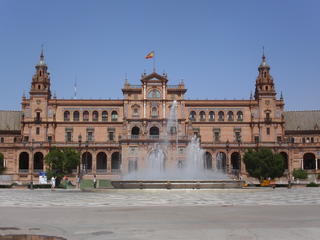 You may recognize the Plaza de Espana from the "Star War" films. When the "Lucas movie team" were looking for a place that reflected the 'Royal planet of Naboo', they visited a number of sites around the world but as soon as they saw the monumental architecture of the "Plaza de Espana" they didn't have to look any further.
You may recognize the Plaza de Espana from the "Star War" films. When the "Lucas movie team" were looking for a place that reflected the 'Royal planet of Naboo', they visited a number of sites around the world but as soon as they saw the monumental architecture of the "Plaza de Espana" they didn't have to look any further.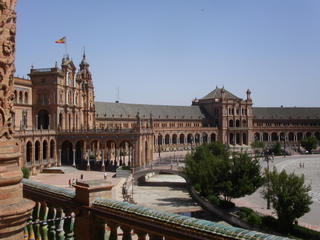 Plaza de Espana is a half-moon-shaped Renaissance-style structure. Today, the plaza mainly comprises government offices while the surrounding moat can be best appreciated by renting out a rowing boat. A vast semicircular complex with fountains, monumental staircases and a mass of tile work, it is quite spectacular.
Plaza de Espana is a half-moon-shaped Renaissance-style structure. Today, the plaza mainly comprises government offices while the surrounding moat can be best appreciated by renting out a rowing boat. A vast semicircular complex with fountains, monumental staircases and a mass of tile work, it is quite spectacular.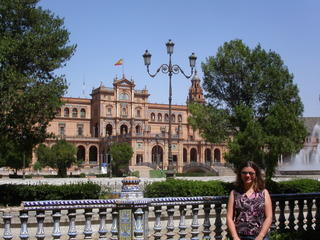 Laid out in 1929 for an abortive 'Fair of the Americas', the Plaza de España and adjoining Maria Luisa Park are among the most pleasant and impressive public spaces in Spain. They are an ideal place to spend the middle part of the day, just ten minutes' walk to the east of the cathedral.
Laid out in 1929 for an abortive 'Fair of the Americas', the Plaza de España and adjoining Maria Luisa Park are among the most pleasant and impressive public spaces in Spain. They are an ideal place to spend the middle part of the day, just ten minutes' walk to the east of the cathedral.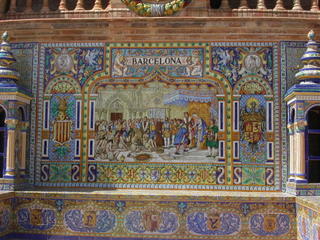 In Plaza de Espana, set into a curved wall are alcoves focusing on the characteristics of Spain's 50 provinces, as depicted in tile murals.
In Plaza de Espana, set into a curved wall are alcoves focusing on the characteristics of Spain's 50 provinces, as depicted in tile murals. La Catedral de Sevilla is the largest Gothic building in the world and the third-largest church in Europe (after St. Peter's in Rome and St. Paul's in London). The Cathedral was designed by builders whose stated goal was that: "those who come after us will take us for madmen."
La Catedral de Sevilla is the largest Gothic building in the world and the third-largest church in Europe (after St. Peter's in Rome and St. Paul's in London). The Cathedral was designed by builders whose stated goal was that: "those who come after us will take us for madmen."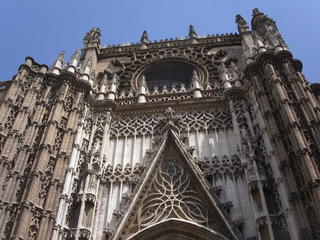 It is one of the last Spanish Gothic cathedrals, and the Renaissance style is already evident. in La Catedral de Sevilla Works of art abound, many of them architectural. In the Treasury are works by Goya, Murillo, and Zurbarán.
It is one of the last Spanish Gothic cathedrals, and the Renaissance style is already evident. in La Catedral de Sevilla Works of art abound, many of them architectural. In the Treasury are works by Goya, Murillo, and Zurbarán.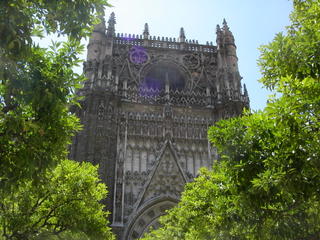 Patio de los Naranjos: Located just outside the Cathedral, the Patio de los Naranjos dates back to Moorish times when worshippers would wash their hands and feet in the fountain here - under the orange trees - before their daily prayers.
Patio de los Naranjos: Located just outside the Cathedral, the Patio de los Naranjos dates back to Moorish times when worshippers would wash their hands and feet in the fountain here - under the orange trees - before their daily prayers. Columbus' Tomb: The cathedral claims to contain the remains of Columbus; his tomb is mounted on four statues.
Columbus' Tomb: The cathedral claims to contain the remains of Columbus; his tomb is mounted on four statues. Pedro the Cruel built this magnificent 14th-century mudéjar palace north of the cathedral. It's the oldest royal residence in Europe still in use. the "gate of the Lion" marks the entrance to the Palace.
Pedro the Cruel built this magnificent 14th-century mudéjar palace north of the cathedral. It's the oldest royal residence in Europe still in use. the "gate of the Lion" marks the entrance to the Palace.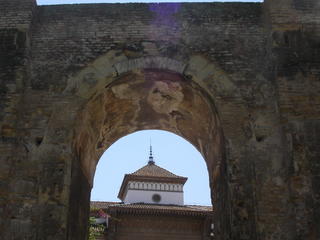 The current Palace is built on the site of Roman fortifications and an Almohada (Moors) Palace from the 1100's. Most of the building on view today was constructed after 1364. In the 1500's, Charles 'V' added a chapel and halls with vaulted ceilings. During the exploration of the Americas, a wing was added to the Palace by Isabel to plan expeditions and direct her rule over the new Spanish territories
The current Palace is built on the site of Roman fortifications and an Almohada (Moors) Palace from the 1100's. Most of the building on view today was constructed after 1364. In the 1500's, Charles 'V' added a chapel and halls with vaulted ceilings. During the exploration of the Americas, a wing was added to the Palace by Isabel to plan expeditions and direct her rule over the new Spanish territories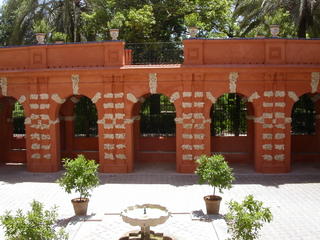 The Gardens of the Seville Palace are a blending of styles, from the time of the Moors to the Renaissance.
The Gardens of the Seville Palace are a blending of styles, from the time of the Moors to the Renaissance.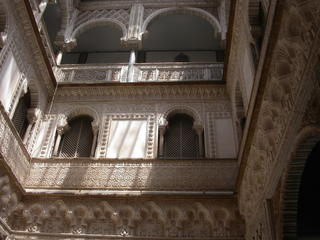 Patio de la Munecas (The Courtyard of the Dolls): Supposedly, this courtyard is named for the two little faces which can be found on the inside of one of the courtyards' arches. It's easy to be fooled into thinking this is a Moorish palace, some of the rooms and courtyards seem to come straight from the Alhambra.
Patio de la Munecas (The Courtyard of the Dolls): Supposedly, this courtyard is named for the two little faces which can be found on the inside of one of the courtyards' arches. It's easy to be fooled into thinking this is a Moorish palace, some of the rooms and courtyards seem to come straight from the Alhambra.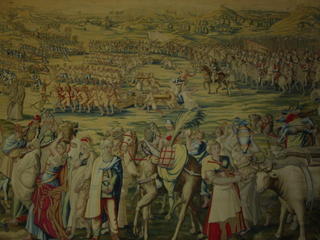 The Salones de Carlos V: These rooms are decorated with beautiful 16th-century azulejos (tiles), and contain a stunning collection of 16th-century tapestries from Brussels that depict the life of the emperor and his conquest of Tunis in 1535.
The Salones de Carlos V: These rooms are decorated with beautiful 16th-century azulejos (tiles), and contain a stunning collection of 16th-century tapestries from Brussels that depict the life of the emperor and his conquest of Tunis in 1535.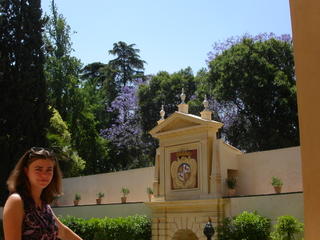 The Alcazar's gardens. At the Alcazar, the real highlight for us was the gardens. There are immaculately maintained terraces with walled courtyards and a series of tranquil ponds.
The Alcazar's gardens. At the Alcazar, the real highlight for us was the gardens. There are immaculately maintained terraces with walled courtyards and a series of tranquil ponds.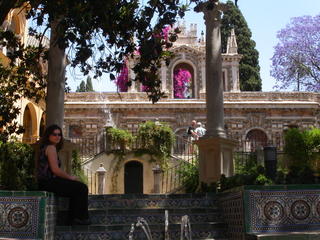 Sara taking a rest before continuing with the rest of the tour.
Sara taking a rest before continuing with the rest of the tour.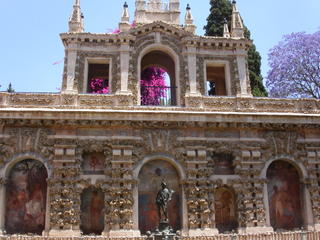 It is amazing the amount of work that went in constructing the walls that surround the Royal Gardens.
It is amazing the amount of work that went in constructing the walls that surround the Royal Gardens.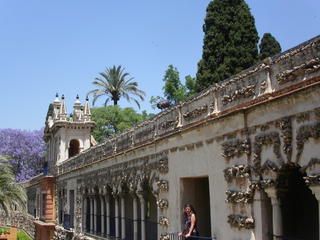
Sara overlooking the Royal Gardens.
No comments:
Post a Comment